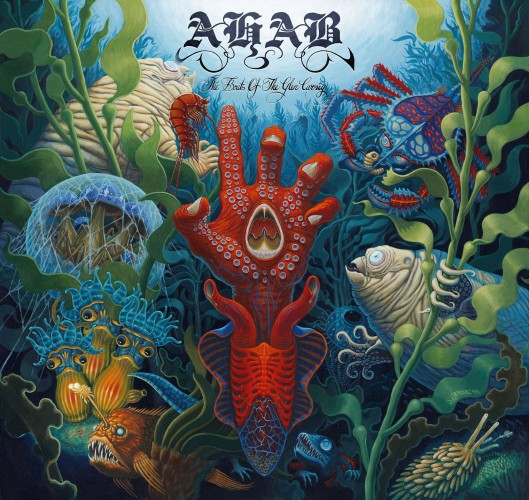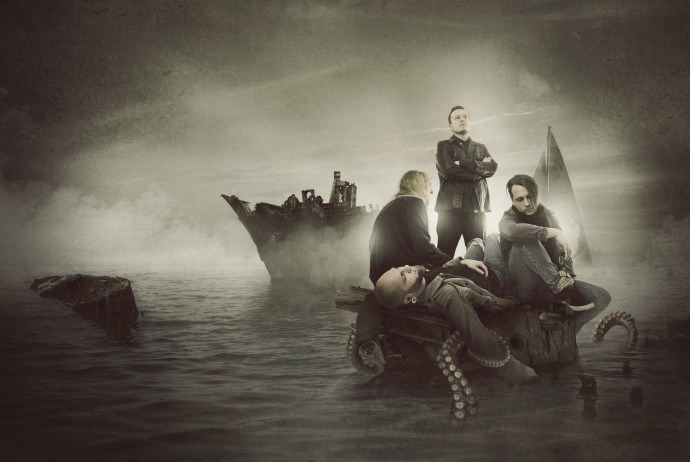(In this post Grant Skelton reviews the new album by Germany’s Ahab.)
I am someone who is relatively new to the Ahab fold. NCS reader blend77 recommended the band to me last year when I was just beginning my descent into the subterranean mausoleum of doom metal lore. Ahab’s 2006 debut The Call Of The Wretched Sea remains their crowning achievement in the minds of many. Nevertheless, I began my exploration of their music with The Giant, the band’s third album released in 2012. From there, I worked my way backward to their 2009 offering The Divinity Of Oceans. I finished with The Call…, which I mentioned above.
Ahab loyalists are aware of the band’s devotion to nautical and marine literature. But if you’re new to Ahab, then you might like to know that their albums are each based on books relating to the ocean. As a writer, this fact immediately enticed me about the band’s music. You see, sometimes metal is like a Z-grade horror film. Sometimes you just want to lay back on your couch, turn on the television, and zone out. You’ve got your trusty go-to food-and-beverage combo while you’re enamored by Transdimensional Transgendered Zombies From Planet Squiddleboxtoastmeat or some other nugget of modern cinematic camp. Plenty of metal bands cater to that particular appetite and I’ve enjoyed my share.
But Ahab needs to be absorbed and mulled over. You certainly can listen to them passively as background noise. But to do so results in an insipid listening experience. That would cause you to miss out on all that Ahab have to offer, particularly on their new album The Boats Of The Glen Carrig. It is an album that must be plunged into headfirst without hesitation. You must follow them on their descent into aquatic oblivion, much like the fate of their namesake. The further down you go, the less you will see. The less you see, the more you will find.
In similar tradition with “Further South” from The Giant, “The Isle” births The Boats Of The Glen Carrig with tranquil, inviting guitar tones that beckon the listener like a siren. “Come,” says the siren, “come and find respite for your debilitated bones. Come and lay your head on these balmy shores.” If you’ve read any of the novel for which this album is named (find a link at the end of this review), then you feel the beleaguered hope of the forlorn band of shipwreck survivors in this song. A hope so steeped in desperation that it is almost hopeless.
Their sight of the land represents a promise, a resolution. Something solid upon which they can bank and build. Something firm and steady where they can find sustenance, healing, and rest from their travails at sea. But the siren’s song is a lie. The sailors are deceived. For “The Isle” offers neither sustenance, nor healing, nor rest. The siren who appears as a scantily-clad sunbathing beauty is a venomous succubus with jaundiced incisors soaked with the blood of her victims. There is no hope on “The Isle.” Only death and doom of a different flavor than the one you just left.
Contrasts like these are one of Ahab’s greatest strengths. On The Boats Of The Glen Carrig, Ahab juxtapose progressive post-metal that is (dare I say!) serene and warm alongside crippling riffs that carry the weight of Stonehenge. But the contrasts do not stop there. This album also sees Ahab stepping forward with the sonic evolution they began on The Giant” I realize that “experimenting” is a loaded term for many bands, reviewers, and fans. But fear not. You won’t see Ahab including dubstep or yarling about ex-girlfriends on this release.
Fans of Ahab’s first two albums, who may still be skeptical of frontman Daniel Droste’s melodic croons, need look no further than the track “The Weedmen.” On my first listen, this track was my favorite on the album. In keeping with our theme of contrasts, “The Weedmen” is the longest (and likely slowest) track in Ahab’s discography. This song is rigor mortis set to music, a pestilent creeping plague equally as unsettling as the creatures for which it is named. “The Weedmen” do indeed come anigh at about the 4:47 mark. This section of the song onward contains some of the album’s strongest riffs and leads.
The album’s third track “Like Red Foam (The Great Storm)” is the shortest and fastest track in Ahab’s repertoire. It serves as a bridge between the album’s longer movements. It is the closest that Ahab have come to writing a “hit,” if I may use that term. Don’t dismiss this song on that account. It may be short and catchy, but that doesn’t stop it from thundering like a tempest. Boats… also features Ahab’s first song with only clean vocals. But don’t let that prevent you from being serenaded by “The Light In The Weed (Mary Madison).” A stark but beautiful ballad, the song stands out because it is the only one of its kind on the release. A diamond among coal.
Make no mistake, this is most assuredly funeral doom. It’s just that the funeral itself does not involve a procession or interment. Instead, the procession is in your final futile gurgles for breath as you drown in the freezing crypt of the vast and unforgiving sea. And the interment is in the waves folding silently over you as you slip namelessly into the deep. An improper burial where the only songs are maritime hymns sung by the water-damned souls of the dead.
Ahab’s The Boats Of The Glen Carrig is available August 28 on Napalm Records.
Stream the entire album over at Cvlt Nation.
Find it here on Amazon, here on iTunes, or get physical copies here.
Ahab on Facebook: https://www.facebook.com/AhabDoom
You can read William Hope Hodgson’s novel The Boats Of The Glen Carrig by following this link to Project Gutenberg.



I’m a huge fan of this record. Never got around to The Giant for some reason though – I should rectify that pronto.
Thanks for reading! And yes, “The Giant” is definitely worth your time.
“Make no mistake, this is most assuredly funeral doom.”
I don’t think you can really say that, funeral doom fans most of the time can’t even agree on what is funeral doom lol
Thanks for review Grant!
I like band’s vision, I like their ambitions, but it seems strange for me – I somehow start to lose interest for them as Ahab grows more popular. Yet, I like band’s evolution and sense of taste. I’ve read William Hope Hodgson’s book when I know that band’s going to dedicated a whole album to his story.
By the way, we did an interview with Chris Hector when Ahab have only one album and he told that they’d like to do a record based on Jules Verne’s story… Where’s it now? Where’s Jules Verne?
I like this review, sincerely I think is hard to describe an album of considerable length and multifaceted as one of the genre in “Funeral Doom Metal” but if somebody knows it we can speak about a deep conception and often, intentionally pensive.
The new album by “Ahab” is marked by a lot of tranquil and sweet melodic passagges to an explosion of cavernous growls and swirly guitar work sustained by rugged changing tempos, exactly like the waves of the sea, sometimes are serene and slow, some other times are furious, slow but majestic in all of their representative overwhelming power, see the track “The Isle”. The song “Like Red Foam” reminds me the germans “The Oceans” for the way in which it was structured, in the end, this album is very emotionally and maybe challenging, like a long song as “The Weedmen” but duration is irrelevant if you consider what this album has to offer, seems a masterpiece to me!
i had forgotten about “Like Red Foam” video, it’s an excellent track. I’m very interested in hearing the rest of the album 🙂